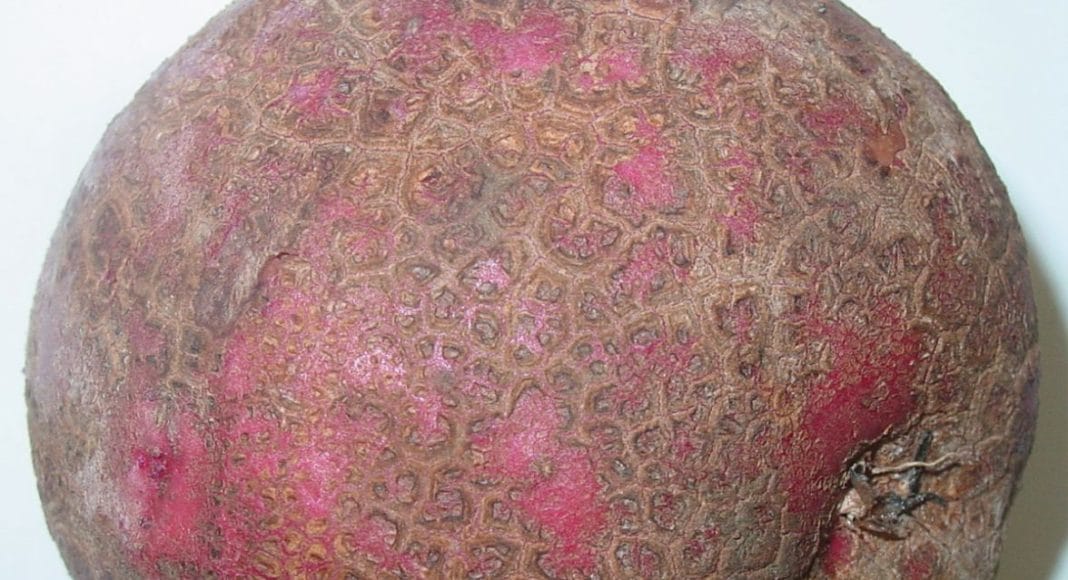An attractive appearance is crucial in the marketing of table potatoes. A clean, shiny, bright-coloured skin free of diseases or other defects is desired in red-skinned cultivars such as Norland, Pontiac and Peregrine. Unfortunately a range of diseases and disorders can interfere with the appearance of red-skinned potatoes.
In some years russeting of the skin is one of the most common quality complaints facing growers of red-skinned potatoes. While a russeted skin is an inherited trait in some potato cultivars such as Netted Gem and Ranger Russet, the development of a russeted skin in red-skinned cultivars is regarded as an undesirable abnormality.
Russeting of red-skinned varieties is usually superficial and restricted to a few patchy areas on the surface of the tuber, while on standard russeted varieties the entire surface of the tuber is covered with a fairly thick layer of russeted tissue. Russeting of red-skinned potatoes can start fairly soon after tuber set but increases in incidence and severity throughout the growing season. Once tubers are harvested there is no further development of the russeting.
While some soil-borne pathogens like rhizoctonia and common scab can cause russeting of potato skin, russeting commonly occurs without any obvious connection to any disease organism. The incidence of russeting has been observed to increase whenever the crop is exposed to stressful temperatures or extremes of soil moisture.
In a recent comprehensive study of russeting of several smooth-skinned cultivars of potato, Ginzberg et al (2012) found that:
a) The russeting was due to the accumulation of dead skin cells on the surface of the potato. Normally these dead skin cells are sloughed off — leaving the skin surface smooth.
b) No differences in the microbial community could be found when russet areas of the tuber surface were compared to normal smooth areas.
c) No obvious differences in soil chemistry were observed between fields prone to russeting and fields where the disorder was uncommon.
d) Tissues taken from russeted areas of the tuber had higher levels of calcium (Ca) and lower levels of potassium (K) than areas where the skin was smooth. The higher levels of Ca in the russeted tissues could be expected to increase the strength of the cell walls and to enhance cell to cell adhesion; both of these factors could explain why normal sloughing of the skin dead cells does not occur — leading to the formation of russet spots.
e) When CaCl2 (750 kilograms/hectare) or KCl (500 kilograms/hectare) fertilizers were added to the soil prior to planting, adding Ca decreased both the incidence and severity of russeting. This result seemed contradictory to the previous finding that elevated levels of tissue Ca were associated with greater problems with russeting. The authors however point out that Ca uptake and allocation within the potato plant are complex processes. Most of the calcium found in potato tubers is absorbed through secondary roots or roots growing on the stolon that attaches the tuber to the mother plant. However, much of the calcium found in the skin of the tuber is actually directly absorbed from the adjacent soil by the skin cells. For that reason, responses to Ca fertilizers applied within the hill and close to the developing tubers may have beneficial effects on Ca nutrition, even in soils which test high for plant available Ca.
f) Maintaining soil moisture levels near field capacity from the time of tuber set through until mid-tuber fill tended to increase problems with russeting. This is noteworthy, as maintaining high moisture levels through this period is a widely recommended practice [since] it enhances yields while also suppressing infection of the tubers by common scab.
The conclusion of the research was that russeting of smooth skinned potatoes is a complex disorder with few obvious options for its management.
Source : Ginzberg, Minz, Faingold, Soriano, Mints, Fogelman, Warshavsky, Zig and Yermiyahu. (2012). Amer. J. Potato Res. 89:351-362.
This article was published on the University of Saskatchewan Vegetable Program website, and is re-printed with the permission of University of Saskatchewan.











